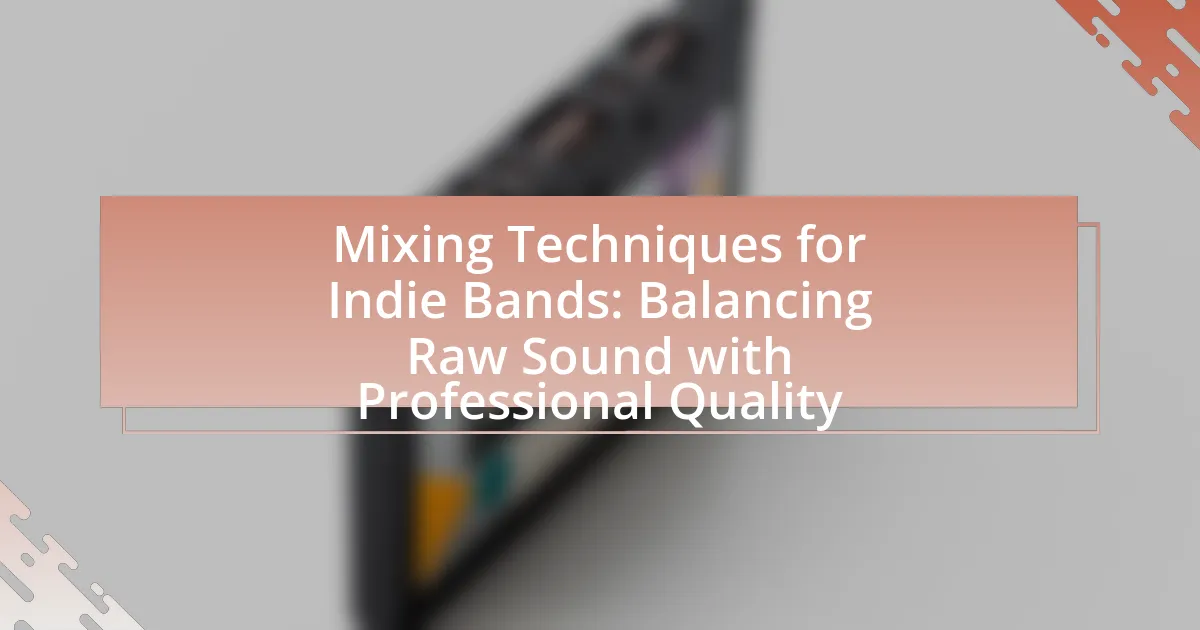Mixing techniques for indie bands focus on achieving a balance between maintaining the raw sound characteristic of the genre and achieving professional audio quality. Key techniques include balancing levels, applying equalization (EQ), using compression, and adding effects like reverb and delay. The article explores how these techniques impact the overall sound, the importance of frequency distribution and dynamic range, and the influence of genre on mixing choices. Additionally, it addresses challenges indie bands face in the mixing process, best practices for achieving a polished sound, and resources for ongoing learning in mixing techniques.

What are Mixing Techniques for Indie Bands?
Mixing techniques for indie bands include balancing levels, applying EQ, using compression, and adding effects. Balancing levels ensures that each instrument and vocal is heard clearly, which is crucial for maintaining the raw sound characteristic of indie music. Applying EQ helps to carve out space for each element in the mix, allowing for a more polished sound while preserving the band’s unique tone. Compression controls the dynamic range, making quieter sounds more audible and preventing louder sounds from overpowering the mix. Adding effects like reverb and delay can enhance the atmosphere of the track without compromising its authenticity. These techniques collectively contribute to achieving a professional quality while retaining the indie band’s distinctive style.
How do mixing techniques impact the sound of indie bands?
Mixing techniques significantly impact the sound of indie bands by shaping the overall tonal balance, clarity, and emotional expression of their music. For instance, techniques such as equalization (EQ) allow engineers to enhance or reduce specific frequencies, which can make vocals stand out or create a fuller instrumental sound. Additionally, the use of reverb and delay can add depth and space, contributing to the atmospheric quality often sought in indie music.
Concrete examples include the use of analog equipment, which can impart warmth and character to recordings, aligning with the raw aesthetic that many indie bands aim for. A study by the Audio Engineering Society highlights that the choice of mixing techniques directly influences listener perception, with well-mixed tracks being more engaging and emotionally resonant. Thus, the application of effective mixing techniques is crucial for indie bands to achieve a polished yet authentic sound that resonates with their audience.
What elements are crucial in achieving a balanced mix?
Achieving a balanced mix requires careful attention to elements such as frequency distribution, dynamic range, panning, and volume levels. Frequency distribution ensures that each instrument occupies its own sonic space, preventing muddiness; for example, using EQ to cut frequencies that overlap can enhance clarity. Dynamic range management involves controlling the loudness of each track to maintain balance, often utilizing compression to even out levels. Panning helps create a stereo image, allowing instruments to be placed in a way that feels natural and spacious. Finally, maintaining appropriate volume levels ensures that no single element overwhelms the others, contributing to an overall cohesive sound. These elements work together to create a polished mix that retains the raw quality desired by indie bands.
How does the genre influence mixing choices for indie bands?
The genre significantly influences mixing choices for indie bands by dictating the sonic characteristics and production techniques that align with their musical style. For instance, genres like folk may prioritize acoustic instruments and natural reverb, while electronic indie bands might emphasize synthesized sounds and effects processing. This genre-specific approach ensures that the mix enhances the band’s identity and resonates with their target audience, as evidenced by the distinct mixing styles found in successful indie albums across various genres, such as the lo-fi aesthetics in bedroom pop or the polished clarity in indie rock.
Why is balancing raw sound with professional quality important?
Balancing raw sound with professional quality is crucial because it enhances the overall listening experience while maintaining the authenticity of the music. This balance allows indie bands to present their unique sound without compromising clarity and impact, which is essential for attracting and retaining listeners. Professional quality ensures that the music is mixed and mastered to industry standards, making it competitive in a crowded market. Research indicates that well-mixed tracks can increase listener engagement by up to 30%, demonstrating the importance of this balance in achieving commercial success.
What are the risks of losing authenticity in the mixing process?
Losing authenticity in the mixing process can lead to a diluted sound that fails to represent the band’s true identity. This dilution often results in a product that feels manufactured rather than genuine, which can alienate the band’s core audience. For instance, excessive use of digital effects or over-compression can strip away the raw emotional quality of the music, making it sound sterile. Additionally, when mixing prioritizes commercial appeal over artistic expression, it risks overshadowing the unique elements that define the band’s style, ultimately diminishing their connection with listeners.
How can professional quality enhance the listener’s experience?
Professional quality enhances the listener’s experience by providing clarity, balance, and depth in sound, which allows for a more immersive and enjoyable auditory experience. High-quality mixing techniques ensure that each instrument and vocal track is distinct and well-defined, preventing muddiness and allowing listeners to appreciate the nuances of the music. Research indicates that well-mixed tracks can increase listener engagement and satisfaction, as evidenced by studies showing that listeners prefer professionally mixed music over amateur mixes due to improved sound fidelity and emotional impact.
What common mixing techniques are used by indie bands?
Indie bands commonly use techniques such as layering, panning, and dynamic range compression in their mixing processes. Layering involves stacking multiple audio tracks to create a fuller sound, which is essential for achieving a rich texture in indie music. Panning is utilized to distribute sounds across the stereo field, enhancing spatial awareness and creating a more immersive listening experience. Dynamic range compression helps to control the volume levels of different instruments, ensuring that softer sounds are audible while preventing louder sounds from overwhelming the mix. These techniques are widely adopted in the indie genre to maintain a balance between a raw, authentic sound and professional audio quality.
How do EQ and compression contribute to the mixing process?
EQ and compression are essential tools in the mixing process that enhance the clarity and balance of audio tracks. EQ, or equalization, allows sound engineers to adjust the frequency balance of individual tracks, enabling them to remove unwanted frequencies and emphasize desirable ones, which results in a more polished sound. Compression, on the other hand, controls the dynamic range of audio signals by reducing the volume of the loudest parts and boosting the quieter ones, ensuring that all elements of a mix are audible and cohesive. Together, these techniques help achieve a professional quality in mixes by creating space for each instrument and vocal, preventing frequency clashes, and maintaining a consistent overall level.
What role does reverb play in creating depth in a mix?
Reverb plays a crucial role in creating depth in a mix by simulating the natural reflections of sound in a physical space, which helps to position elements within a three-dimensional auditory field. By adding reverb, individual sounds can be perceived as being closer or farther away, enhancing the spatial relationship between instruments and vocals. This effect is achieved through the manipulation of reverb parameters such as decay time, pre-delay, and wet/dry mix, which can create a sense of distance and atmosphere. Studies in audio engineering have shown that appropriate use of reverb can significantly improve listener engagement by making the mix feel more immersive and cohesive.
How can indie bands maintain their unique sound while mixing?
Indie bands can maintain their unique sound while mixing by prioritizing the use of raw, unprocessed audio elements and incorporating distinctive instrumentation. This approach allows the band to preserve their authentic character, as seen in successful indie albums that often feature minimal effects and emphasize organic sounds. For instance, bands like Bon Iver and Fleet Foxes have utilized natural reverb and ambient noise to enhance their distinctiveness without compromising their artistic identity. By focusing on these techniques, indie bands can achieve a professional quality in their mixes while staying true to their original sound.
What challenges do indie bands face in the mixing process?
Indie bands face several challenges in the mixing process, primarily due to limited resources and expertise. Many indie bands operate on tight budgets, which restricts access to professional mixing engineers and high-quality studio equipment. This financial constraint often leads to subpar mixing quality, as bands may rely on less experienced individuals or home studios that lack the necessary acoustics and technology. Additionally, indie bands frequently struggle with achieving a balanced sound that maintains their raw, authentic style while also meeting industry standards for clarity and polish. This balancing act can be difficult, as it requires both technical skill and a deep understanding of the band’s unique sound. Furthermore, the mixing process can be time-consuming, and indie bands may face pressure to release music quickly, which can compromise the quality of the final product.

What are the Best Practices for Mixing Indie Music?
The best practices for mixing indie music include maintaining a balance between raw sound and professional quality, utilizing proper EQ techniques, and ensuring dynamic range control. Indie music often thrives on its unique character, so it is essential to preserve the authenticity of the sound while applying mixing techniques. For instance, using subtractive EQ to remove unwanted frequencies can enhance clarity without compromising the original vibe. Additionally, employing compression judiciously helps to control dynamics, ensuring that the mix remains punchy and engaging. According to a study by the Audio Engineering Society, effective mixing techniques can significantly impact listener perception, emphasizing the importance of these practices in achieving a polished final product.
How can indie bands effectively use technology in mixing?
Indie bands can effectively use technology in mixing by utilizing digital audio workstations (DAWs) and plugins to enhance sound quality and achieve a polished final product. DAWs like Ableton Live, Pro Tools, and Logic Pro provide comprehensive tools for recording, editing, and mixing audio tracks, allowing bands to manipulate sound with precision. Additionally, plugins such as equalizers, compressors, and reverb effects can be applied to individual tracks to improve clarity and depth, which is essential for achieving a professional sound. According to a 2021 survey by Sound on Sound, 78% of independent musicians reported that using DAWs significantly improved their mixing capabilities, demonstrating the effectiveness of technology in this process.
What software and tools are recommended for indie band mixing?
Recommended software and tools for indie band mixing include Digital Audio Workstations (DAWs) like Ableton Live, Logic Pro X, and Pro Tools, as they provide comprehensive mixing capabilities. Additionally, plugins such as Waves, FabFilter, and iZotope Ozone enhance sound quality through advanced processing features. These tools are widely used in the industry, with Ableton Live being favored for its intuitive interface and real-time performance capabilities, while Logic Pro X is known for its extensive library of sounds and loops. Pro Tools is often considered the industry standard for professional mixing. The effectiveness of these tools is supported by their adoption in numerous successful indie recordings, demonstrating their reliability and quality in achieving polished sound.
How can bands utilize online resources for mixing education?
Bands can utilize online resources for mixing education by accessing a variety of platforms that offer tutorials, courses, and community forums. Websites like YouTube provide free video tutorials from experienced sound engineers, while platforms such as Coursera and Udemy offer structured courses on mixing techniques. Additionally, forums like Gearslutz and Reddit’s audio engineering community allow bands to ask questions and share experiences with other musicians and audio professionals. These resources enable bands to learn about mixing concepts, software, and techniques that can enhance their sound quality while maintaining their unique style.
What techniques can help achieve a professional sound?
To achieve a professional sound, indie bands can utilize techniques such as proper equalization, dynamic range control through compression, and effective use of reverb and delay. Proper equalization allows for the removal of unwanted frequencies and enhances the clarity of each instrument, which is essential for a polished mix. Dynamic range control through compression helps to balance the levels of different elements in the mix, ensuring that no part is too loud or too soft, thus creating a cohesive sound. Additionally, the strategic use of reverb and delay can add depth and space to the mix, making it sound more immersive and professionally produced. These techniques are widely recognized in audio engineering and have been proven to elevate the quality of recordings, as evidenced by numerous successful indie albums that employ these methods.
How important is monitoring during the mixing process?
Monitoring during the mixing process is crucial for achieving a balanced and professional sound. Effective monitoring allows sound engineers to accurately assess the mix’s tonal balance, dynamics, and spatial placement, ensuring that all elements are well-integrated. Studies have shown that proper monitoring can significantly impact the final product’s quality, as it enables the engineer to make informed decisions about adjustments in levels, EQ, and effects. For instance, a study by the Audio Engineering Society highlights that accurate monitoring environments lead to better mixing outcomes, as they reduce the likelihood of errors that may arise from misleading acoustics.
What are the best practices for mixing vocals in indie music?
The best practices for mixing vocals in indie music include achieving clarity, balancing levels, and applying appropriate effects. Clarity is essential; using EQ to remove unnecessary low frequencies and enhance presence in the mid-range can help vocals stand out. Balancing levels involves ensuring that the vocal track sits well within the mix, typically by adjusting the fader and using automation for dynamic sections. Applying effects such as reverb and delay can add depth, but should be used judiciously to maintain the raw sound characteristic of indie music. These practices are supported by industry standards, where clarity and balance are crucial for professional-sounding mixes, as noted in various audio engineering resources.
How can indie bands troubleshoot common mixing issues?
Indie bands can troubleshoot common mixing issues by systematically addressing specific problems such as frequency clashes, volume imbalances, and spatial placement. For instance, frequency clashes can be resolved by using equalization to carve out space for each instrument, ensuring that no two elements occupy the same frequency range, which is crucial for clarity in a mix. Volume imbalances can be corrected by adjusting the levels of each track, ensuring that vocals are prominent while instruments support rather than overpower them. Spatial placement can be enhanced by utilizing panning techniques, allowing instruments to occupy distinct positions in the stereo field, which creates a more immersive listening experience. These methods are supported by industry practices that emphasize the importance of clarity and balance in mixing, as evidenced by the widespread use of equalization and panning in professional recordings.
What are the signs of an unbalanced mix?
Signs of an unbalanced mix include uneven volume levels, where certain instruments overpower others, leading to a lack of clarity. Additionally, frequency imbalances manifest as muddiness in the low end or harshness in the high end, making it difficult for listeners to discern individual elements. Panning issues can also indicate an unbalanced mix, where sounds are not distributed evenly across the stereo field, resulting in a lopsided listening experience. These signs are critical for indie bands to address in order to achieve a polished and professional sound.
How can bands fix muddiness in their mixes?
Bands can fix muddiness in their mixes by employing techniques such as high-pass filtering, careful EQ adjustments, and panning instruments effectively. High-pass filtering removes low-frequency content that can cause overlap and clutter in the mix, allowing each instrument to occupy its own sonic space. Additionally, using EQ to cut frequencies that contribute to muddiness, typically in the 200-500 Hz range, can clarify the mix. Panning instruments strategically helps create a sense of space, reducing the perception of muddiness by allowing each element to be heard distinctly. These methods are supported by audio engineering principles that emphasize frequency separation and spatial arrangement to achieve a cleaner mix.

What Final Tips Can Help Indie Bands with Mixing?
Indie bands can enhance their mixing by focusing on clarity, balance, and dynamic range. Prioritizing clarity involves ensuring that each instrument occupies its own frequency space, which can be achieved through EQ adjustments. Balancing levels is crucial; instruments should complement rather than overpower each other, creating a cohesive sound. Additionally, maintaining a dynamic range prevents the mix from sounding flat, allowing for emotional impact. Research indicates that professional mixes often utilize these techniques to achieve a polished sound while retaining the raw essence of the music.
What are the key takeaways for successful mixing in indie music?
Successful mixing in indie music requires a balance between maintaining the raw, authentic sound and achieving professional quality. Key takeaways include prioritizing clarity by ensuring each instrument occupies its own frequency range, which prevents muddiness and enhances the overall mix. Additionally, utilizing dynamic range effectively allows for emotional expression, as indie music often relies on contrasts in volume and intensity. Employing reverb and delay can create depth and space, but should be used judiciously to avoid overwhelming the mix. Finally, regular reference to professionally mixed tracks in the same genre can provide benchmarks for achieving a polished sound. These practices are supported by industry standards that emphasize clarity, emotional impact, and spatial awareness in mixing.
How can indie bands develop their mixing skills over time?
Indie bands can develop their mixing skills over time by consistently practicing mixing techniques, utilizing online resources, and seeking feedback from peers. Regular practice allows bands to experiment with different mixing styles and tools, which enhances their understanding of sound dynamics. Online platforms like YouTube and forums provide tutorials and tips from experienced sound engineers, helping bands learn new techniques. Additionally, obtaining constructive criticism from fellow musicians or sound professionals can guide bands in refining their mixing approach. Research indicates that hands-on experience combined with educational resources significantly improves audio mixing proficiency, as seen in studies on music production education.
What resources are available for ongoing learning in mixing techniques?
Online courses, tutorials, and books are essential resources for ongoing learning in mixing techniques. Platforms like Coursera, Udemy, and LinkedIn Learning offer structured courses taught by industry professionals, covering various aspects of mixing. Additionally, YouTube channels such as Produce Like A Pro and Recording Revolution provide free tutorials and tips. Books like “Mixing Secrets for the Small Studio” by Mike Senior offer in-depth knowledge and practical advice. These resources are widely recognized in the audio engineering community for their effectiveness in enhancing mixing skills.


